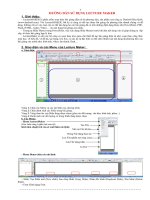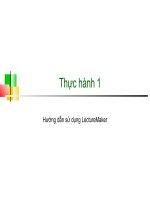Lecture Masticatory muscles
Bạn đang xem bản rút gọn của tài liệu. Xem và tải ngay bản đầy đủ của tài liệu tại đây (3.93 MB, 9 trang )
§THE JAW MUSCLES
(MASTICATORY MUSCLES)
People’s Teacher
Prof. Hoàng Tử Hùng, DDS, PhD
E:
W: hoangtuhung.com
Introduction
1- the jaw muscles are muscles which arise from or insert in the mandible and which
act to the movement of the mandible
2- Any single action of the mandible is the product of the closely integrated and highly
coordinated performance of several jaw muscles
3- In a symmetrical movement the homologous muscles on either side are synergists
and antagonists in an asymmetrical movement
4- The simplified classification of mandibular movement is usually described as follow:
elevation, depression, protrude, retrude, and lateral movement, however, the real
movements are complex patterns in which many of the single movement are combined
5- The branches of mandibular nerve (V-3 cranial nerve) control and regulate activities
of all jaw muscles except the geniohyoid muscle by hypoglossal nerve (XII cranial nerve)
WWW.HOANGTUHUNG.COM
The Jaw muscles consist of:
The elevator muscles:
‒ The (two) masseter muscle(s)
‒ The (two) medial (internal) pterygoid muscle(s)
‒ The (two) temporal muscle(s)
The depressor muscles:
‒ The (two) lateral pterygoid muscle(s)
‒ The suprahyoid muscles
‒ The (two) digastric muscle(s)
‒ The (two) mylohyoid muscle(s)
‒ The (two) geniohyoid muscle(s)
WWW.HOANGTUHUNG.COM
The masseter
The elevator muscles
- The masseter
- The medial pterygoid
- The temporal
Origin:
- Superficial part: anterior two-thirds
of
zygomatic arch
- Deep part: interior surface of zygomatic arch
Insertion:
- Superficial part: mandibular angle
- Deep part: mandibular ramus
Action:
Elevates the mandible
Superficial part involved in protrusion
WWW.HOANGTUHUNG.COM
The medial pterygoid muscle
The elevator muscles
- The masseter
- The medial pterygoid
- The temporal
Origin: pterygoid fossa and maxillary tuberosity
Insertion: medial aspect of mandibular angle
and distal aspect of the ramus
Action:
Elevates the mandible and involved in lateral
movements
WWW.HOANGTUHUNG.COM
The temporal muscle
The elevator muscles
- The masseter
- The medial pterygoid
- The temporal
Origin: 3 portions
‒ Temporal portion: temporal fossa
‒ Fascial portion: temporal fascia
‒ Zygomatic portion: internal aspect of
zygomatic arch
Insertion: internal aspect of coronoid process
and anterior margin of the ramus
Action: elevates the mandible
anterior belly involve in protrusion)
posterior belly retracts the mandible
Temporal muscle is the most sensitive
muscle with the occlusal interferences
WWW.HOANGTUHUNG.COM
The lateral pterygoid muscle
Lateral pterygoid m.
Superior belly
Inferior belly
Medial
pterygiod m.
buccinator
The depressor muscles:
‒ The lateral pterygoid muscle
‒ The suprahyoid muscles
‒ The digastric muscle
‒ The mylohyoid muscle
‒ The geniohyoid muscle
Origin:
- Superior belly (Sb): lower surface of sphenoid
- Inferior belly (Ib): 3/4 inferior of lateral aspect of
lateral lamina of pterygoid process
Insertion:
- Sb: anterior portion of the disc and capsule
- Ib: pterygoid fossa of the neck of the mandible
Action:
Sb contracts during retrusion and closing of mouth
Ib contracts in protrusion and opening of mouth
If only one side contracts: contralateral lateral
movement
WWW.HOANGTUHUNG.COM
The digastric muscle
Origin: mastoid notch (posterior belly)
Insertion: digastric fossa of mandible (anterior
belly)
An intermediate tendon is between the anterior
and the posterior belly that is attached by a
fascial looplike strip to the hyoid
Action:
- When the hyoid bone is fixed (by suprahyoid
and infrahyoid muscles): the mandible is
depressed and pulled backward
- When mandible is stabilized: digastric and other
suprahyoid elevate the hyoid bone and the floor
of mouth, which is necessary for deglutition
The depressor muscles:
‒ The lateral pterygoid muscle
‒ The suprahyoid muscles
‒ The digastric muscle
‒ The mylohyoid muscle
‒ The geniohyoid muscle
WWW.HOANGTUHUNG.COM
the mylohyoid muscle
Origin: mandibular mylohyoid line
Insertion: mylohyoid raphe and hyoid body
Action: depresses mandibular, elevates floor
of mouth and hyoid bone
Anatomically: forms the floor of the mouth,
separating it from suprahyoid region
The depressor muscles:
‒ The lateral pterygoid muscle
‒ The suprahyoid muscles
‒ The digastric muscle
‒ The mylohyoid muscle
‒ The geniohyoid muscle
The geniohyoid muscle
Origin: inferior genial tubercle
Insertion: body of hyoid
Action: contributes to mylohyoid muscle action
1
WWW.HOANGTUHUNG.COM









